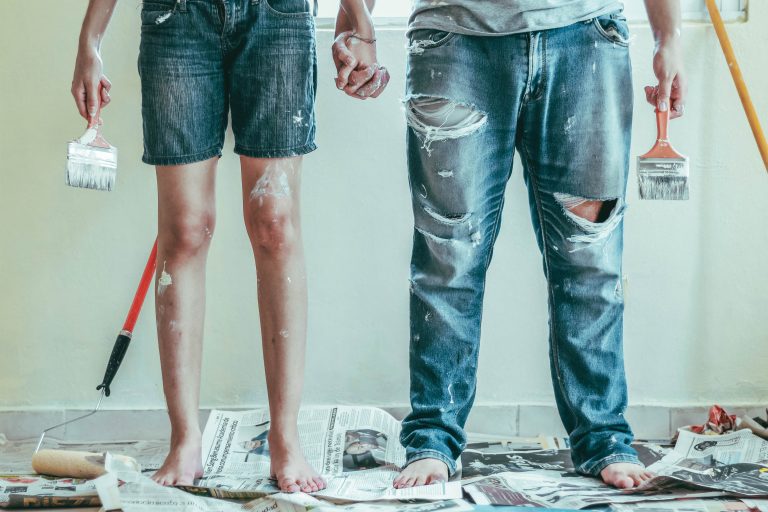There’s no denying that chalk paint has taken the home decorating world by storm. There are many creative ways to use chalk paint around your home. From refurbishing vintage furniture to sprucing up your bedroom walls, these projects are sure to help you master everyone’s favorite new painting technique. If you’re looking for new ideas, read on for three creative ways to use chalk paint at home.
Chalk Paint Vs. Chalkboard Paint
Chalk paint and chalkboard paint are two very different products. Made famous by Annie Sloan, chalk paint is a type of paint that contains a high concentration of pigment and dries to a matte finish. It’s often used for painting furniture or cabinets because it adheres well to most surfaces and requires little prep work.
Chalkboard paint, on the other hand, is a paint that contains a fine-grained powder that allows you to write on it with chalk once it’s dry. It’s commonly used for things like kids’ playrooms or home offices.
The subtle matte look of chalk paint often pairs beautifully with chalkboard paint to create a playful, country-chic setting.
Now that you know the difference between the two let’s get into some creative uses for chalk paint around the house!
Layer Chalk Paint For a Distressed Front Door
There are many advantages to painting your front door. If you’re planning to move soon, giving your door a makeover is one of the most cost-effective ways to stand out to buyers. Even if you’re not, it’s a quick project that can easily pay for itself down the line.
Whether you live in a historic house or a modern mansion with old-world charm, a distressed front door can create a relaxed and welcoming first impression when guests arrive.
To do this, start by choosing three different shades of chalk paint. For the best results, use complementary blends of cool and warm colors.
Prepare the door for painting using the same steps listed in the step above. After putting down each layer, use mid-grit sandpaper to expose the base layers.
The key to success is varying your intensity with the sandpaper. Rubbing hard will reveal the lowest layers of paint, while a more gentle approach will show off the higher layers.
Experienced DIYers can use spray-on casement paint and vaseline to get a one-of-a-kind “crackling” effect.
Make Old Furniture New (But Not Too New) With Chalk Paint
One of the most popular uses for chalk paint is to refinish old furniture. It’s a great way to give new life to an old piece while upholding its vintage charm.
Chalk paint sticks to most surfaces, but you’ll still want to thoroughly clean, sand, and prime your piece before coating it with chalk paint.
The best cleaning products for your project will depend on the type of wood you’re preparing to paint. Generally, a window cleaner or an alcohol-based solution will get the job done.
Up next, it’s time to get the surface ready for paint. Deep grooves, holes, and knots can be remedied with wood filler. Then, you can rub the entire object down with sandpaper or a power sander.
Many antique furniture items include a high-gloss finish that’s challenging to paint over. These items might require a bit more elbow grease than the average piece.
Before painting, you’ll want to coat your furniture with a primer. This step is crucial for dark-colored furniture, which is susceptible to bleeding through chalk paint.
Applying the chalk paint is the last and most fun step! Begin by painting a section with long, even strokes. Work in small sections and paint over any drips or smudges immediately.
You can achieve different looks by playing around with the paint’s texture. For a stylishly worn look, use opposing brush stroke directions to create a cross-hatch pattern.
Use Wax For the Ultimate Chalk Paint Experience
Chalk paint is a great product, but it’s not without challenges. One of the most significant issues is that it can be difficult to get an even, consistent coat.
One way to avoid this problem is by using wax. Applying a clear or tinted wax layer will give your chalk paint job a beautiful shine while protecting it from the elements.
To apply wax, start by heating it with a hairdryer set on low. Then, use a clean cloth to apply the wax in small sections. Work the wax into the paint until you’ve achieved the desired level of coverage.
For an extra-shiny finish, buff the waxed surface with a soft cloth.
Achieve Rustic-Chic Perfection With Chalk Paint
If you’re looking for a way to add instant character to your home, chalk paint is the answer. With its non-pretentious appeal and endless possibilities, chalk paint can help you achieve DIY perfection when renovating and remodeling. We hope these tips have inspired you to give chalk paint a try. What project will you tackle first?

